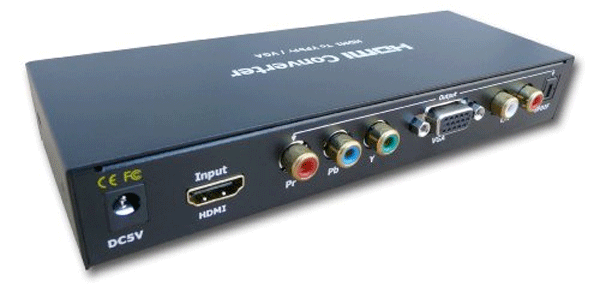Producing Conference Video Pt. 3: Shooting Presentations and Directing Live Switches
Award-winning producer Shawn Lam looks at two key elements of the process: capturing multimedia presentations effectively for both live-switched productions and post-produced edits, and how to become a successful technical director of a live-switched shoot, whether for IMAG delivery or providing a live feed for broadcast or webcast.
Scan Conversion
Sometimes you need to record a multimedia presentation that isn't limited to slides that can be converted, which is the case for software or website demonstrations. One solution is to take a direct video feed from as close to the source as possible. Typically, a projector will be connected to the presenter's laptop with a VGA cable, although I've seen DVI and HDMI used on occasion. Most laptops don't have a second VGA out, as like is common with most modern desktop computers, so a powered VGA splitter is used to amplify and split the video signal. Most of the time there will already be a VGA splitter in place if the video is being projected on a second screen or if a confidence monitor is provided for the speaker (think of it as the video equivalent of a musicians onstage reference loudspeaker speaker/monitor).
If this is the case then coordinating with your client and the A/V company to make sure that they have an extra output or can swap their splitter for a larger output model is usually pretty easy. If they aren't already splitting the feed, introducing a 1:2 model to the flow will give both you and the projector a video feed. Just make sure to get enough VGA cable or a VGA balun with Cat5 cable for more information on baluns) to reach your position and avoid VGA splitting cables, as they are not designed for long distance splits and can introduce unwanted noise.
Splitting a VGA signal is pretty easy, every-day task for A/V companies, but recording this signal is another matter. There are some devices that can directly record a VGA signal, but generally a scan converter is used to convert the VGA signal, which is almost always a higher resolution than 720x480 SD video and a lower resolution than 1920x1080 HD video, to a resolution, color-space, and signal type that matches your video camera and recording parameters. Look to rent or purchase a scan converter that outputs RCA, S-Video, and/or component video, as these are formats you can easily record or input into a live video mixer.

An HDMI-capable scan converter
Downconversion to SD video has the obvious challenge that the lower resolution means that smaller fonts are often too small to read, especially when the video will be delivered in a lower web video resolution. The problem is exacerbated when working with widescreen video for both acquisition and delivery and a 4:3 multimedia projection aspect ratio. Good communication with presenters to encourage them to design and deliver their presentations in widescreen to match the video is helpful, and encouraging them to add additional slides to highlight key points in slides that have too much content makes a big difference to the video version. Unfortunately, this isn't always possible for conferences with outside presenters.
Both presentation screens and projectors, along with online video delivery, are moving closer towards a similar, if not common widescreen and HD resolution, which will make these issues a concern of the past; however, during our current transitional phase, video professionals need to be able to keep their workflows flexible.
Related Articles
Whether you're shooting a conference, a convention, or an AGM, the setup of the shoot is one of the most important parts of the production process. It's the step where you select the equipment, establish your camera positions, lay your cables, and check and recheck your audio and lighting.
What happens when you deliver your event live? This is nothing new for live TV broadcasters, but more and more event video producers are being asked to perform their postproduction activities in real-time—that is, live as the event is occurring.
Award-winning producer Shawn Lam looks at the art and science of stage lighting and the challenges of making lighting designed for performance work for video. He also discusses the meat-and-potatoes things you need to know for microphone selection and successful live-recorded conference audio.